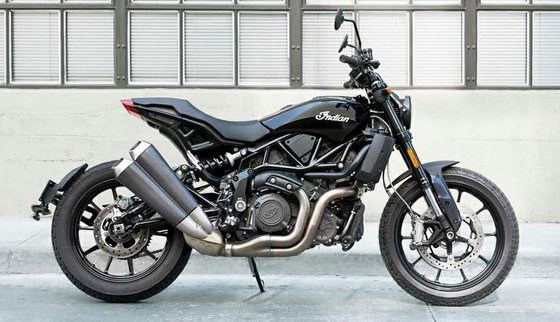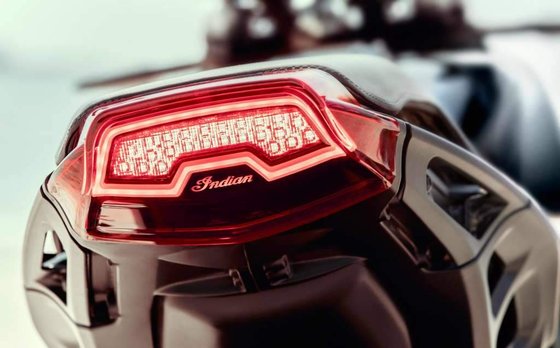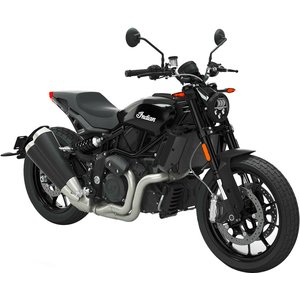Indian FTR 1200 [2019-2022]: A Flat-Track Legend Reimagined for the Street

When Indian Motorcycle unveiled the FTR 1200 in 2019, it wasn’t just launching a new motorcycle—it was reigniting a legacy. Inspired by the championship-winning FTR750 flat-track racer, the FTR 1200 brought the raw, unfiltered spirit of dirt oval racing to the asphalt. For riders seeking a blend of American muscle, agile handling, and head-turning design, the FTR 1200 carved out a niche that defied traditional cruiser stereotypes. After spending time with this machine, it’s clear why it remains a standout in the motorcycle world—even years after its debut.
Design: Where Heritage Meets Modern Aggression

The FTR 1200’s design is an instant conversation starter. From its trellis frame to the under-seat fuel tank (a nod to the FTR750’s weight distribution), every detail screams “race bike for the street.” The high-mounted exhaust, knuckle guards, and flat-track-inspired Metzeler or Dunlop tires (depending on the model year) give it a purposeful stance. Even the Akrapovič exhaust on higher trims, like the FTR R Carbon, adds a visual and auditory edge.
The bike’s proportions are compact but muscular. At 840 mm (33.1 inches), the seat height is approachable for most riders, though the Rally and Carbon editions lower it further to 780 mm (30.7 inches). The tapered ProTaper handlebars and mid-mounted footpegs create a sporty, upright riding position—perfect for carving corners or navigating city traffic. Paint options like Thunder Black, Maroon Metallic, and limited-edition schemes (e.g., the Championship Edition’s race livery) ensure the FTR stands out in a sea of monotony.
Performance: A V-Twin That Rewrites the Rules
Engine & Transmission
At the heart of the FTR 1200 lies a 1203cc liquid-cooled V-twin—a departure from Indian’s air-cooled traditions. This engine is a masterpiece of modern engineering, delivering 123 HP (89.8 kW) and 117.9 Nm (87 lb-ft) of torque. The powerband is linear, with a surge of low-end grunt that pulls hard from 3,000 RPM and doesn’t let up until the 8,500 RPM redline. Unlike many cruisers, this engine loves to rev, channeling its inner sportbike soul.
The 6-speed gearbox is crisp, though the clutch can feel heavy in stop-and-go traffic. Higher trims add a slip-and-assist clutch, reducing lever effort. The belt drive (2019-2020) was later swapped for a 525 chain to better suit aggressive riding—a welcome change for enthusiasts.
Riding Modes & Electronics
Later models (S, R Carbon) introduce Sport, Standard, and Rain modes, altering throttle response and traction control intervention. The Ride Command 4.3-inch touchscreen (2022+) is intuitive, offering Bluetooth connectivity and ride data. While purists might prefer the base model’s analog gauges, the tech suite elevates the FTR into modern territory.
Handling: A Streetfighter in Disguise

The FTR’s chassis is its secret weapon. The steel trellis frame, paired with fully adjustable Sachs or Öhlins suspension (depending on trim), strikes a balance between stability and agility. Early models featured a 26.3° rake and 130 mm (5.1 inches) of trail, but 2022 revisions sharpened the geometry to 25.3° rake and 99.9 mm (3.9 inches) trail—transforming the bike into a corner-carving beast.
17-inch wheels (2022+) wrapped in Metzeler Sportec tires replace the original 19-/18-inch combo, improving turn-in response. Despite a dry weight of 218-230 kg (480-507 lbs), the FTR feels surprisingly light on its feet. The Brembo brakes—dual 320mm front discs with 4-piston calipers—deliver stellar stopping power, though ABS can’t be fully disabled on earlier models.
Technology: More Than Just a Pretty Face
- LED Lighting: The aggressive headlight and taillight design improve visibility while reinforcing the bike’s modern aesthetic.
- Cruise Control: A godsend on long highway stretches.
- Cylinder Deactivation: Reduces heat soak during city riding—a thoughtful touch.
- Cornering ABS & Traction Control: Standard on premium trims, adding confidence in wet conditions.
Competition: How the FTR Stacks Up
The FTR 1200 occupies a unique space between muscle cruisers and naked sportbikes. Here’s how it fares against key rivals:
1. Ducati Monster 1200
- Pros: Lighter, sharper handling, and a more refined electronics package.
- Cons: Lacks the FTR’s characterful V-twin and flat-track charm. Pricier to customize.
2. Triumph Speed Twin 1200
- Pros: Classic British styling, smoother parallel-twin engine.
- Cons: Less aggressive ergonomics and inferior suspension adjustability.
3. Harley-Davidson Sportster S
- Pros: Revolutionary Revolution Max 1250 engine, lower seat height.
- Cons: Polarizing design, less engaging chassis.
4. Yamaha MT-09 SP
- Pros: Lighter, cheaper, and a riotous CP3 triple-cylinder engine.
- Cons: Budget suspension and plasticky build quality compared to the FTR.
Verdict: The FTR 1200 isn’t the fastest or lightest, but its blend of American brawn, customization potential, and race-bred DNA makes it irresistible for riders seeking individuality.
Maintenance: Keeping Your FTR in Peak Condition

The FTR 1200 is relatively low-maintenance, but a few key areas demand attention:
1. Oil Changes
- Interval: Every 8,000 km (5,000 miles).
- Oil Type: SAE 15W-60 full synthetic (3.8L with filter). Consider upgrading to Motul 300V for track days.
2. Chain Care (2021+ Models)
- Lubrication: Use a high-quality chain lube (e.g., Maxima Chain Wax) every 500 km (310 miles).
- Tension: Maintain 40-50 mm (1.6-2 inches) of slack.
3. Tire Pressure
- Front: 2.5 bar (36 psi) / Rear: 2.8 bar (41 psi). Adjust for loaded touring.
4. Brake Fluid
- Replace: Every 2 years with DOT 4 fluid. Brembo High Performance fluid enhances lever feel.
5. Upgrades to Consider
- Exhaust: Swap the stock system for an Akrapovič Slip-On (Euro 5-compliant models).
- Suspension: Öhlins cartridges ($$$) or Wilbers shocks improve ride quality.
- Seat: The stock seat can be punishing after an hour—opt for a Corbin Gunfighter for all-day comfort.
Final Thoughts: A Motorcycle That Demands to Be Ridden

The Indian FTR 1200 isn’t perfect—it’s thirstier than its rivals (12.9L/3.4-gallon tank), and the mirrors vibrate at highway speeds. But flaws fade when you’re leaned over in a corner, the V-twin howling through an Akrapovič exhaust, the suspension compressing just enough to let you know it’s working. This is a motorcycle that rewards skill and begs for customization. Whether you’re chasing knee-down thrills or turning heads on Main Street, the FTR 1200 delivers an experience no other bike can replicate.
At MOTOPARTS.store, we’re here to help you make it yours—because every FTR deserves a touch of rebellion.
















































Specifications sheet
| Engine | |
|---|---|
| Stroke: | Four-stroke |
| Max power: | 123 kW | 165.0 hp |
| Max torque: | 120 Nm |
| Fuel system: | Closed Loop Sequential Port Fuel Injection, 60mm throttle body |
| Max power @: | 6000 rpm |
| Displacement: | 1203 ccm |
| Max torque @: | 5900 rpm |
| Bore x stroke: | 102.0 x 73.6 mm (4.0 x 2.9 in) |
| Configuration: | V |
| Cooling system: | Liquid |
| Compression ratio: | 12.5:1 |
| Number of cylinders: | 2 |
| Valves per cylinder: | 4 |
| Features | |
|---|---|
| Exhaust: | Akrapovič 2-1-2 system (Carbon/R models) |
| Lighting: | Full LED system with headlight, taillight, and turn signals |
| Electronics: | ['Ride modes (Sport/Standard/Rain)', 'Traction control', 'Wheelie control', 'Cornering ABS', 'Cruise control'] |
| Instrumentation: | 4.3" Ride Command touchscreen (S/R Carbon models) or analog-digital combo |
| Special editions: | ['Championship Edition (400 units)', 'Stealth Gray SE (150 units)'] |
| Dimensions | |
|---|---|
| Wheelbase: | 1524-1525 mm (60-60 in) |
| Dry weight: | 230 |
| Wet weight: | 233 |
| Seat height: | 780-840 mm (30.7-33.1 in) |
| Overall width: | 830-867 mm (32.7-34.1 in) |
| Overall height: | 1166-1390 mm (45.9-54.7 in) |
| Overall length: | 2223-2287 mm (87.5-90 in) |
| Ground clearance: | 165-183 mm (6.5-7.2 in) |
| Fuel tank capacity: | 12.9-13 L (3.4-3.4 US gal) |
| Drivetrain | |
|---|---|
| Chain type: | 525 HV3X |
| Final drive: | Chain |
| Gear ratios: | ['1st 12.270:1', '2nd 8.341:1', '3rd 6.646:1', '4th 5.639:1', '5th 4.985:1', '6th 4.278:1'] |
| Transmission: | 6-speed, assist-and-slip wet multi-plate clutch |
| Primary drive: | Gear drive wet clutch |
| Rear sprocket: | 47 |
| Front sprocket: | 15 |
| Final drive ratio: | 2.647:1 |
| Maintenance | |
|---|---|
| Rear tire: | 150/70-18 (2019-2021), 180/55z-17 (2022) |
| Engine oil: | 15W60 |
| Front tire: | 120/70-19 (2019-2021), 120/70z-17 (2022) |
| Brake fluid: | DOT 4 |
| Spark plugs: | NGK MR7F |
| Spark plug gap: | 0.8 |
| Coolant capacity: | 2.2 |
| Engine oil capacity: | 3.8 |
| Engine oil change interval: | Every 5000 km or 2 years |
| Valve clearance (intake, cold): | 0.10–0.20 mm |
| Valve clearance check interval: | 24,000 km (15,000 mi) |
| Valve clearance (exhaust, cold): | 0.20–0.30 mm |
| Recommended tire pressure (rear): | 2.8 bar (41 psi) |
| Recommended tire pressure (front): | 2.5 bar (36 psi) |
| Chassis and Suspension | |
|---|---|
| Frame: | Steel trellis |
| Trail: | 99.9-130 mm (3.9-5.1 in) |
| Lean angle: | 43 |
| Rear brakes: | Single 260-265mm disc, Brembo 2-piston caliper (ABS standard) |
| Front brakes: | Dual 320mm discs, Brembo 4-piston radial calipers (ABS standard) |
| Rear suspension: | Fully adjustable piggyback IFP shock (120-150 mm travel) |
| Front suspension: | Fully adjustable inverted 43mm telescopic cartridge fork (120-150 mm travel) |
| Rake (fork angle): | 25.3°-26.3° |



















